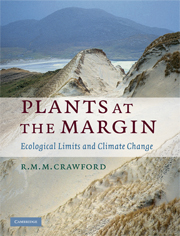Book contents
- Frontmatter
- Contents
- Preface
- Acknowledgements
- PART I THE NATURE OF MARGINAL AREAS
- PART II PLANT FUNCTION IN MARGINAL AREAS
- PART III MARGINAL HABITATS – SELECTED CASE HISTORIES
- 5 Arctic and subarctic treelines and the tundra–taiga interface
- 6 Plant survival in a warmer Arctic
- 7 Land plants at coastal margins
- 8 Survival at the water's edge
- 9 Woody plants at the margin
- 10 Plants at high altitudes
- 11 Man at the margins
- 12 Summary and conclusions
- References
- Author index
- Species index
- Subject index
7 - Land plants at coastal margins
Published online by Cambridge University Press: 06 July 2010
- Frontmatter
- Contents
- Preface
- Acknowledgements
- PART I THE NATURE OF MARGINAL AREAS
- PART II PLANT FUNCTION IN MARGINAL AREAS
- PART III MARGINAL HABITATS – SELECTED CASE HISTORIES
- 5 Arctic and subarctic treelines and the tundra–taiga interface
- 6 Plant survival in a warmer Arctic
- 7 Land plants at coastal margins
- 8 Survival at the water's edge
- 9 Woody plants at the margin
- 10 Plants at high altitudes
- 11 Man at the margins
- 12 Summary and conclusions
- References
- Author index
- Species index
- Subject index
Summary
CHALLENGES OF THE MARITIME ENVIRONMENT
Coastal regions present both opportunities and challenges to plants. On one hand, reduction of temperature extremes, combined in many instances with freedom from frost and drought, extends the potential distribution for species that are intolerant of climatic extremes. On the other hand, the constant threat of habitat destruction, coupled with the physical stresses of wind exposure, salt drenching, burial and flooding, renders coastal regions marginal areas for many species (Fig. 7.1).
Climatic warming and its consequences for sealevel rise are already having an increasing impact on coastal habitats. Coastal vegetation has always had to adjust to changes in sea level. Since the peak of the last ice age about 18,000 years ago the sea has risen more than 120 metres. The greater part of this change took place over 6000 years ago. Over the past 3000 years the sea level has been largely constant, rising by about 0.1 to 0.2 mm per year. Over the last 50 years, however, the average rate of sea-level change obtained from tidal gauges has risen to + 1.8 ± 0.3 mm yr−1. The rate now seems to be rising more rapidly. Since 1992 satellite altimetry measurements have shown an average rise of +3.1 ± 0.4 mm yr−1 (Nerem et al., 2006). It is now probable that this recent acceleration (Fig. 7.2) represents the first signs of the effect of global warming on sea level (Houghton et al., 2001).
- Type
- Chapter
- Information
- Plants at the MarginEcological Limits and Climate Change, pp. 225 - 272Publisher: Cambridge University PressPrint publication year: 2008



